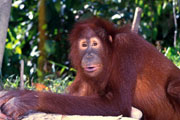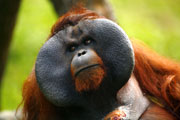Cognition & Intelligence
In a captive setting, Bornean orangutans have demonstrated an exceptionally high level of intelligence and cognitive ability. Individuals have shown an adept ability to learn and use human sign language to convey and ask for various things in a coherent and grammatically well-structured format. They have used lexigram boards successfully; boards where symbols are used to represent words in order to communicate with human behavioural researchers. In a wild setting, orangutans show the same level of cognitive capability, revealed through extensive ongoing research which is investigating their construction, manipulation and use of tools; made mainly from sticks and leaves. Tools are used for a range of purposes, from extracting seeds from fruits with specially-prepared sticks and using bunched, large leaves as 'umbrellas'; to using leaves to gather drinking water and using sticks to scratching themselves. A major aspect of their cognitive capability is associated with their ability to generate, remember and utilise large 'mind maps' of the forest, centring on trees bearing fruit at different times throughout the year and their ability to correctly identify several hundred species of edible plants.
Diet & Feeding Ecology
Bornean orangutans are predominantly frugivorous, with fruits accounting on average for over 60% of their diets. Orangutans have been seen to eat over 400 different species of plants, with fruit species such as figs (Ficus spp.) and durian (Durio spp.) focusing heavily within their diets. In addition, orangutans also eat a wide variety of foods, including leaves, bark, vines, orchids, reed roots; a range of non-plant foods such as fungi, bird eggs, termites, caterpillars, ants, honey and even spider webs. Orangutans (especially on Sumatra) have been seen to eat meat and even hunt opportunistically. Individuals have been seen eating slow lorises and rats and one occasion, and even a dead gibbon although it is not known whether the gibbon was already dead.
An important event for Bornean orangutans is the phenomenon of 'mast fruiting' whereby a large number of trees fruit simultaneously. This is usually at infrequent intervals ranging from two to ten years. During these mass-fruiting events, orangutans feed exclusively on fruit, far-exceeding their necessary daily calorific intake and subsequently putting on extra reserves of fat for the future. During these and other more regular periods of high fruit availability, it is the males which consume more calories and spend more time feeding.
Photographs kindly provided by David Slater, Nick Bramley, STA
Bornean orangutan (Pongo pygmaeus) orang-utan ape facts - intelligence diet feeding - Borneo Sabah South East Asia - Wildlife Holiday Responsible Travel


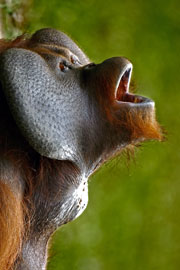
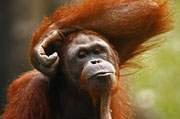
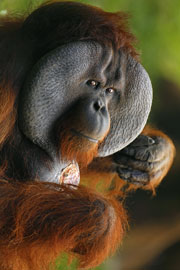
.jpg)
